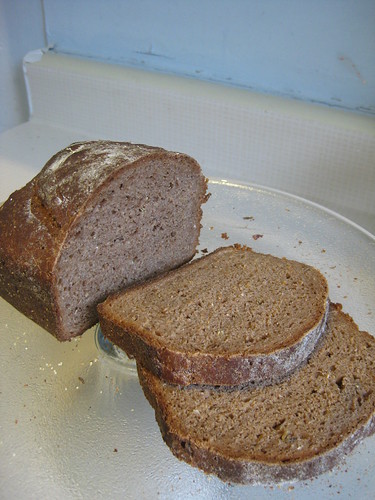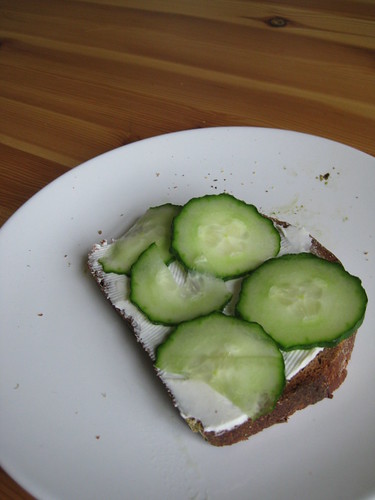But this is different.


Everyone already knows of my love for quick breads (see banana bread, soda bread). This week I have moved on to yeast breads. First endeavor: black bread, which is basically a stronger version of pumpernickel. This bread is rather dense but still gives a nice crumb. I followed this recipe almost exactly, and was shocked by my success.
Update: I've made this bread about five times since, and I've adapted the original recipe enough to justify typing it up here. I use it so often that I keep the (modified) measurements posted on my fridge:
Recipe: black breadI really encourage you all to try making your own bread--read these bread-making tips for solid advice. The one I found most helpful was placing a shallow dish of water on the bottom rack of the oven for the first 15 minutes of baking. Often I have problems with the crust hardening too soon (before the loaf fully expands), but the water adds extra moisture in the oven to prevent this.
(makes one loaf)
1 package active dry yeast
1 tsp sugar
0.25 cup warm water
1 cup water
1/8 cup molasses
1/8 cup apple cider vinegar
2 tbsp (28g) butter
0.5 oz (14g) unsweetened chocolate
0.5 tbsp instant coffee powder
0.5 cup all-purpose flour
1.25 cup whole wheat flour
1.5 cup rye flour
0.5 cup bran
1 tbsp caraway seeds
0.25 tsp fennel seeds
0.5 tbsp salt
0.5 to 1 tbsp minced shallot
- Stir the yeast, sugar and warm water together in a small bowl, and do not disturb until the mixture has about doubled in size and looks frothy.
- Sift together the all-purpose, rye and whole wheat flours.
- Melt the butter and chocolate, then mix with water, vinegar, molasses and coffee powder. Allow the liquid to cool off before proceeding to the next step.
- Add one cup of the flour mixture, along with the bran, caraway seeds, fennel seeds, salt, and shallots, to a large bowl. Add the liquid from the previous step, and the yeast. Mix.
- Continue by adding flour to the large bowl, one half cup at a time. Keep going until a cohesive mass is achieved, i.e. the dough begins to clear the sides of the bowl as you stir it. The dough should be pretty sticky, but firm.
- Knead the dough on a floured surface until it is springy/dense/until your hands are tired.
- Place the dough (should be in the shape of a ball) in a greased bowl. Cover the bowl and let the dough rise for about an hour until it has doubled in size.
- Gently deflate the dough, then form it into a loaf. Position your loaf in a greased loaf pan, then cover and allow it to rise (again) to twice its size. At this point you can preheat your oven to 350 degrees.
- Bake the loaf in the center of the oven for about 45 minutes. It should have a deep brown crust. Be sure to check on it half-way and three-quarters through the baking time, just in case it's an early riser (HA).
I will continue to document my bread exploits here--in particular I'm hoping to develop some original recipes.

if I am becoming Indian, you are definitely becoming Russian.
ReplyDelete